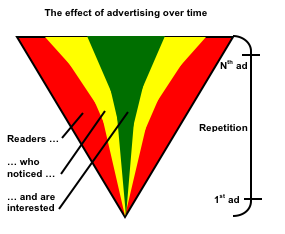Most business owners rightly feel they have better things to do than play around with social media.
At the same time, it’s not an exaggeration to say social media has revolutionized marketing. It allows any business to engage in “content marketing” – essentially developing its own audience at little or no cost, and engaging with them to drive interest in sales. To ignore this is to ignore the behavior of your customers and prospects.
 But with so many social media outlets, it’s often hard to know where to get started or what to do next.
But with so many social media outlets, it’s often hard to know where to get started or what to do next.
Every social media site has its own peculiarities and best practices. Learning the nuances of each, takes a certain amount of time and commitment. So I recommend getting involved in one platform at a time. Start with Facebook, for instance, and work it until you’re comfortable about how it adds value. Only then should you look to add another platform.
At the same time, understand that social media outlets are like ingredients in a sandwich. A piece of ham tastes good, but it’s not lunch until you put it between slices of bread and add tomato, cheese and mustard. With social media, you may need to layer 3 or 4 different sites before you have a program that actually drives revenue to your business.
As an example, most of my social media clients combined Facebook and Twitter – and in some cases a third relevant site – before they gained traction at building audience.
Here is a basic overview of the major social media outlets and what each one brings to your marketing. All are trying to find services you’ll pay for, but they can still be used effectively for free.
Facebook
What it’s for: The foundation of any social media marketing – particularly if your products/services are targeted to a consumer audience. Use it to aggregate an audience of people who are interested in what you sell or do.
Strengths: A billion users. Easy and low-cost advertising. Integrates with many other prominent social media outlets (i.e., when you post on Twitter, for example, it’s easy to have the Tweet automatically post to Facebook as well). Finally, the best adoption in mobile computing – allowing you to easily capitalize on the astoundingly fast migration to mobile devices.
Weaknesses: Constantly changing. Noisy, commercial and often unpleasant to use. Takes commitment to feed it with content.
Nuance: Don’t use your personal page for business. Set up a business page; you’ll look more professional and once you have 30 “likes” it provides you with valuable data to improve your marketing – still for free.
LinkedIn
What it’s for: Social media networking specifically for business. If your products/services are targeted to a business audience, start here instead of Facebook.
Strengths: Many ways to find and engage relevant audience.
Weaknesses: Doesn’t integrate well with other social media. It’s also become so rich with features that it is becoming difficult to use. Further, some of the best features are now reserved for paid users.
Nuance: Despite the negatives, it’s still the largest and most robust business-to-business networking tool available. You’ll want both a personal page and a business page.
Twitter
What it’s for: Broadcasting headlines. Use it to let people know you have new content to share – whether it’s on Facebook, LinkedIn, your own website or anywhere else.
Strengths: The accepted standard for deploying brief messages. Also strong on mobile platforms.
Weaknesses: Low signal-to-noise ratio. You need a lot of followers here to count on your messages being seen.
Nuance: Because Tweets are so brief, you’ll want to shorten any website links that you broadcast with a free utility like tinyurl.com, bitly.com or goo.gl. Also, the fastest way to gain an audience is to automatically follow anyone who follows you. There are a number of tools that help with this, such as TwitterAutoFollowback (rolls right off the tongue, doesn’t it?) or Twollow.
YouTube
What it’s for: Everything video. If you’re going to use video, then you want to use YouTube. Even if a video is posted on your website, you should put a copy of it on YouTube as well for the visibility in search.
Strengths: The accepted standard for all things video.
Weaknesses: It’s not much good for anything else.
Nuance: If you’re going to post multiple videos, create a channel for your business and promote it on your website, other social media sites and in your marketing materials.
Slideshare
What it’s for: Posting presentations of all kinds. It’s owned by LinkedIn and integrates well with it.
Strengths: Easy to use and well-known in business-to-business environmenbts.
Weaknesses: Doesn’t integrate well with sites other than LinkedIn.
Nuance: Load it up with whatever presentations you have – technical materials, sales presentations, workshops and anything else you do. It’s surprising how much time people spend browsing through presentations once they’ve found the one they’re looking for. Also, upload presentations as PDFs to assure broadest accessibility to your information.
Google+
What it’s for: Even social media experts will tell you that they don’t really know what Google+ is best at. It’s intended as Google’s answer to Facebook. It is often appreciated for being less commercial and crowded than Facebook, but if you’re beginning a social media program, that can be a disadvantage. Facebook may be noisy, but it has tools designed to make marketing easy. Success on Google+ demands more sophistication in social media marketing.
Strengths: Google’s most powerful attribute is search, and the promise is that anything you post using Google+ will be easier to find on the world’s best-used search engine.
Weaknesses: No sense of place. Facebook is a destination. Google+ is a concept.
Pinterest
What it’s for: Creating online bulletin boards filled with images. If your product or service is visually oriented, use Pinterest to create relevant collections of photos and show them to your audience.
Strengths: Easy to use and integrates well with other sites. So you can feed content to Pinterest and have it automatically post to Facebook and Twitter.
Weaknesses: Typically viewed as a site for women, though that reputation is fading.
Nuance: Pinterest is a social platform in itself, and it wants you to gather followers. But you can use it to organize and display photos while focusing your “audience development” efforts on Facebook and Twitter.
Instagram
What it’s for: Very much like Pinterest. But it originated as a photo-enhancement app for smart phones and it maintains that heritage today. While Pinterest is about organizing collections of images, Instagram is more about taking, dressing up and sharing photos (and now, short videos).
Strengths: Integrates with other social media.
Weaknesses: How many different ways do you really need to take a picture or video?
Foursquare
What it’s for: Geographic social media; people check in to places they visit. By encouraging people to check in, you create visibility on the Foursquare network.
Strengths: Creates attention to storefront businesses that rely on heavy traffic.
Weaknesses: Not much buzz about it these days.
There are plenty more social media platforms, but if you’re not already deep into social media, don’t go beyond what’s contained here. Pick an appropriate place to start and then get comfortable using it.
Social media doesn’t have to take over your life, but if you want people to know about your business, it should be at least a regular part of it.
 Success in marketing isn’t about finding the one thing that works; it’s about cultivating a range of activities that, cumulatively, bring in the customers you need. Some of the best activities cost little and exploit your own interests.
Success in marketing isn’t about finding the one thing that works; it’s about cultivating a range of activities that, cumulatively, bring in the customers you need. Some of the best activities cost little and exploit your own interests. introduce the next round of artists. It also has a small seating area and a location appropriate for small music combos to perform.
introduce the next round of artists. It also has a small seating area and a location appropriate for small music combos to perform. While that proved unworkable, he and the school created a sponsorship program that brought in money for the athletic department and promoted Sweetie Fry during games. Several times throughout each home game, the PA announcer would ask a local trivia question. The prize? A certificate for free Sweetie Fry ice cream.
While that proved unworkable, he and the school created a sponsorship program that brought in money for the athletic department and promoted Sweetie Fry during games. Several times throughout each home game, the PA announcer would ask a local trivia question. The prize? A certificate for free Sweetie Fry ice cream.


